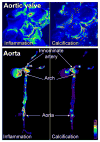Molecular imaging insights into early inflammatory stages of arterial and aortic valve calcification
- PMID: 21617135
- PMCID: PMC3139950
- DOI: 10.1161/CIRCRESAHA.110.234146
Molecular imaging insights into early inflammatory stages of arterial and aortic valve calcification
Abstract
Traditional imaging modalities such as computed tomography, although perfectly adept at identifying and quantifying advanced calcification, cannot detect the early stages of this disorder and offer limited insight into the mechanisms of mineral dysregulation. This review presents optical molecular imaging as a promising tool that simultaneously detects pathobiological processes associated with inflammation and early stages of calcification in vivo at the (sub)cellular levels. Research into treatment of cardiovascular calcification is lacking, as shown by clinical trials that have failed to demonstrate the reduction of calcific aortic stenosis. Hence, the need to elucidate the pathways that contribute to cardiovascular calcification and to develop new therapeutic strategies to prevent or reverse calcification has driven investigations into the use of molecular imaging. This review discusses studies that have used molecular imaging methods to advance knowledge of cardiovascular calcification, focusing in particular on the inflammation-dependent mechanisms of arterial and aortic valve calcification.
Conflict of interest statement
Figures



References
-
- Murphy WA, Jr, Nedden Dz D, Gostner P, Knapp R, Recheis W, Seidler H. The iceman: Discovery and imaging. Radiology. 2003;226:614–629. - PubMed
-
- Otto CM. Calcific aortic stenosis--time to look more closely at the valve. N Engl J Med. 2008;359:1395–1398. - PubMed
-
- Johnson RC, Leopold JA, Loscalzo J. Vascular calcification: Pathobiological mechanisms and clinical implications. Circ Res. 2006;99:1044–1059. - PubMed
Publication types
MeSH terms
Grants and funding
LinkOut - more resources
Full Text Sources
Other Literature Sources
Medical

